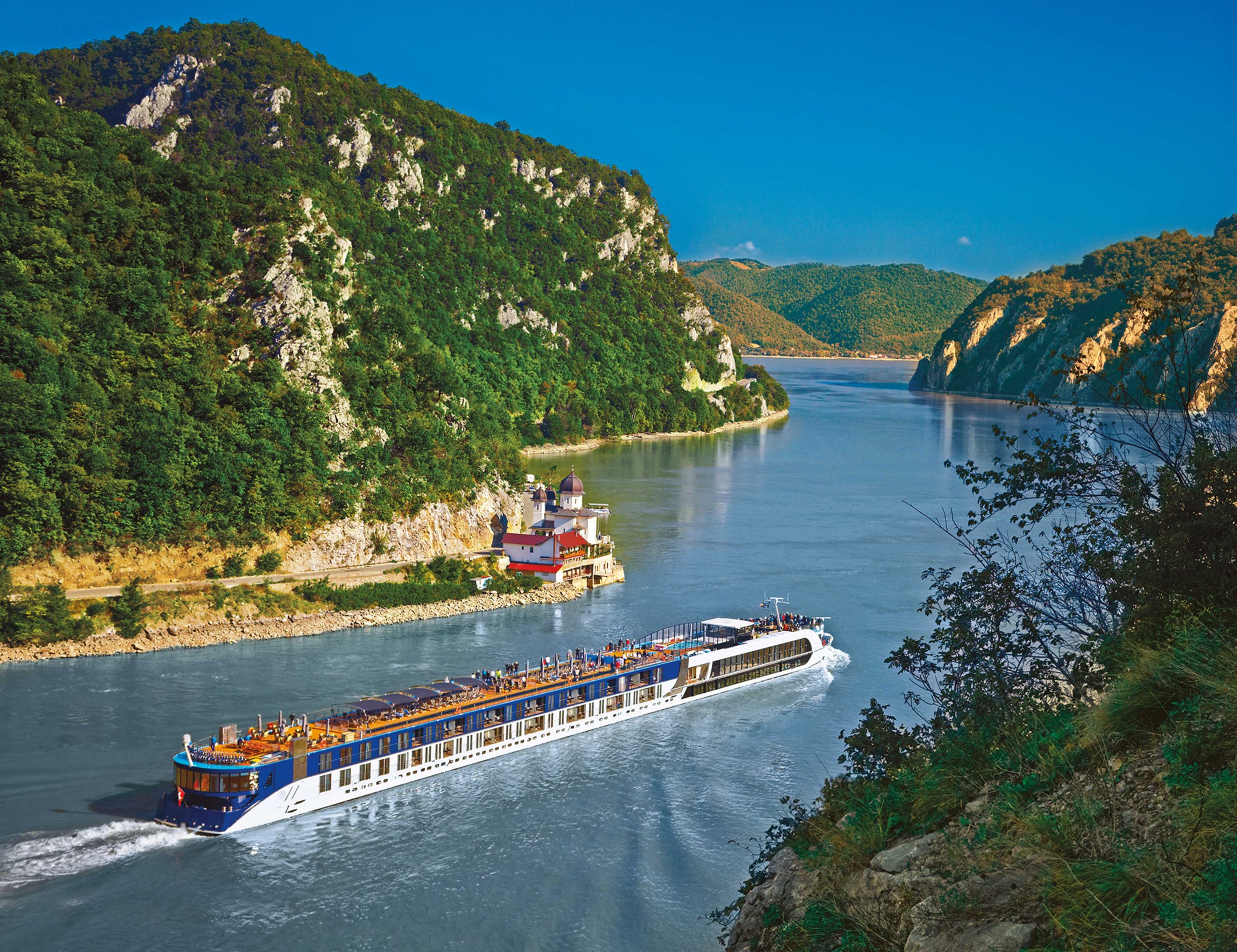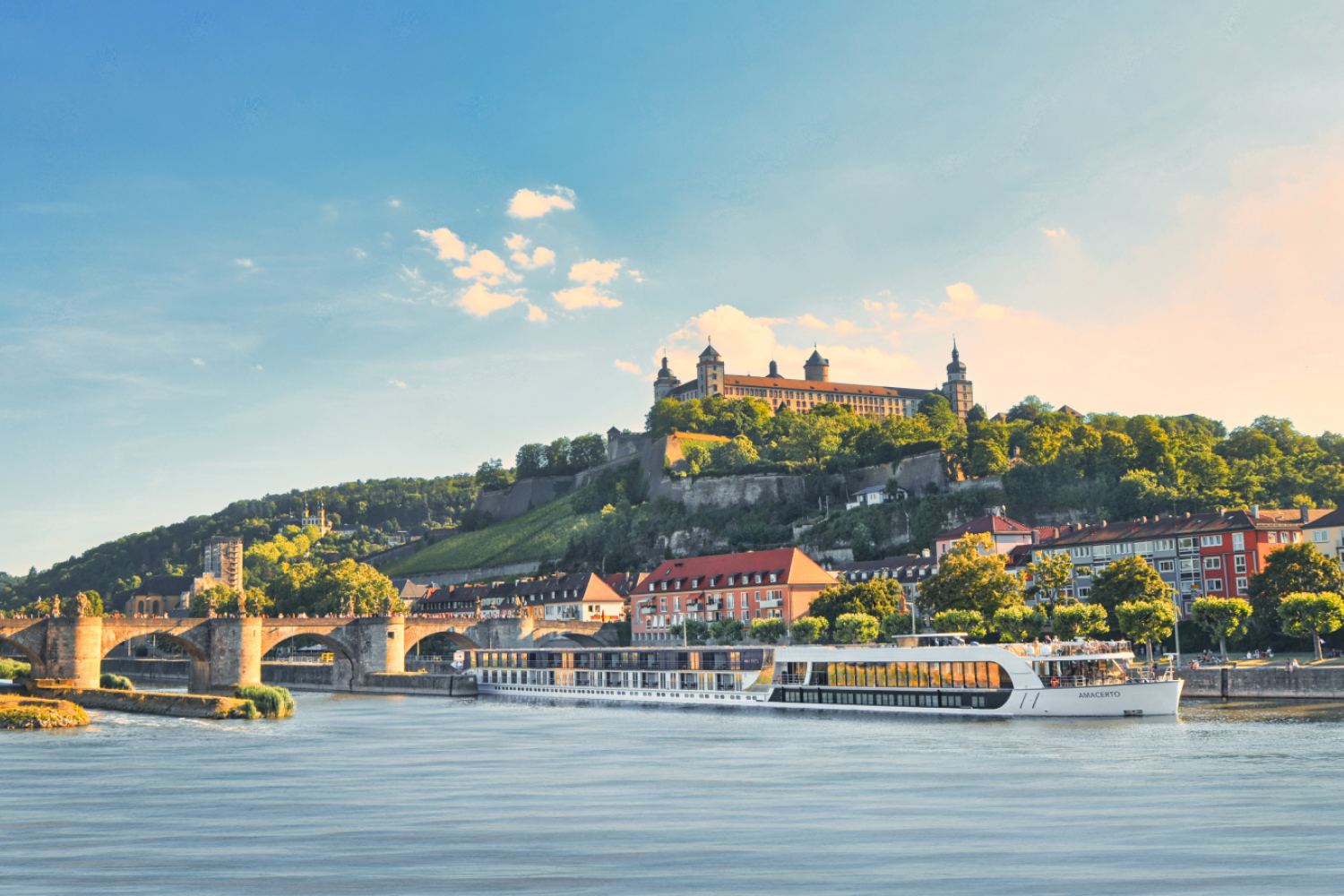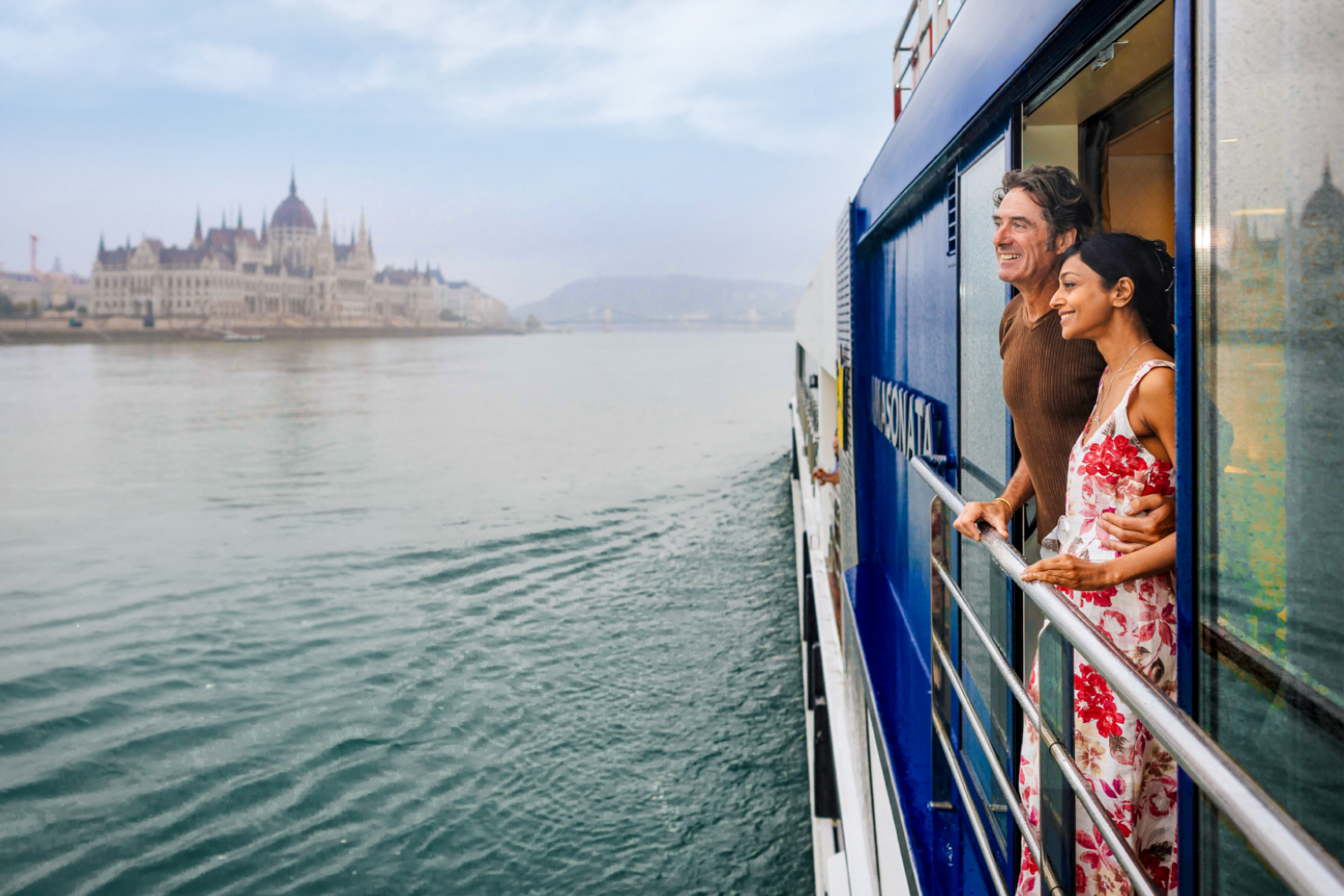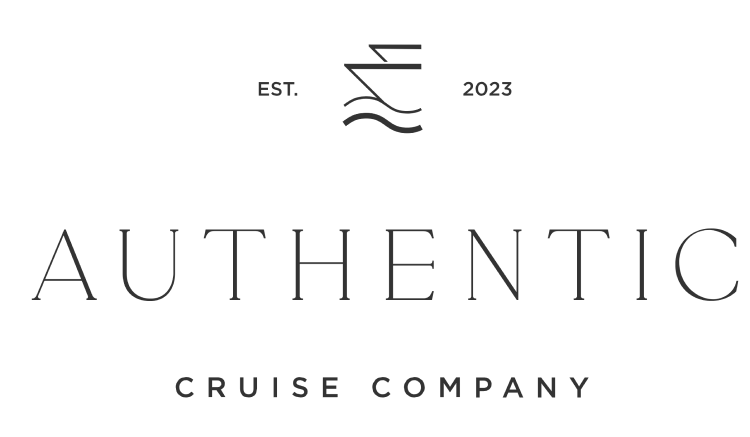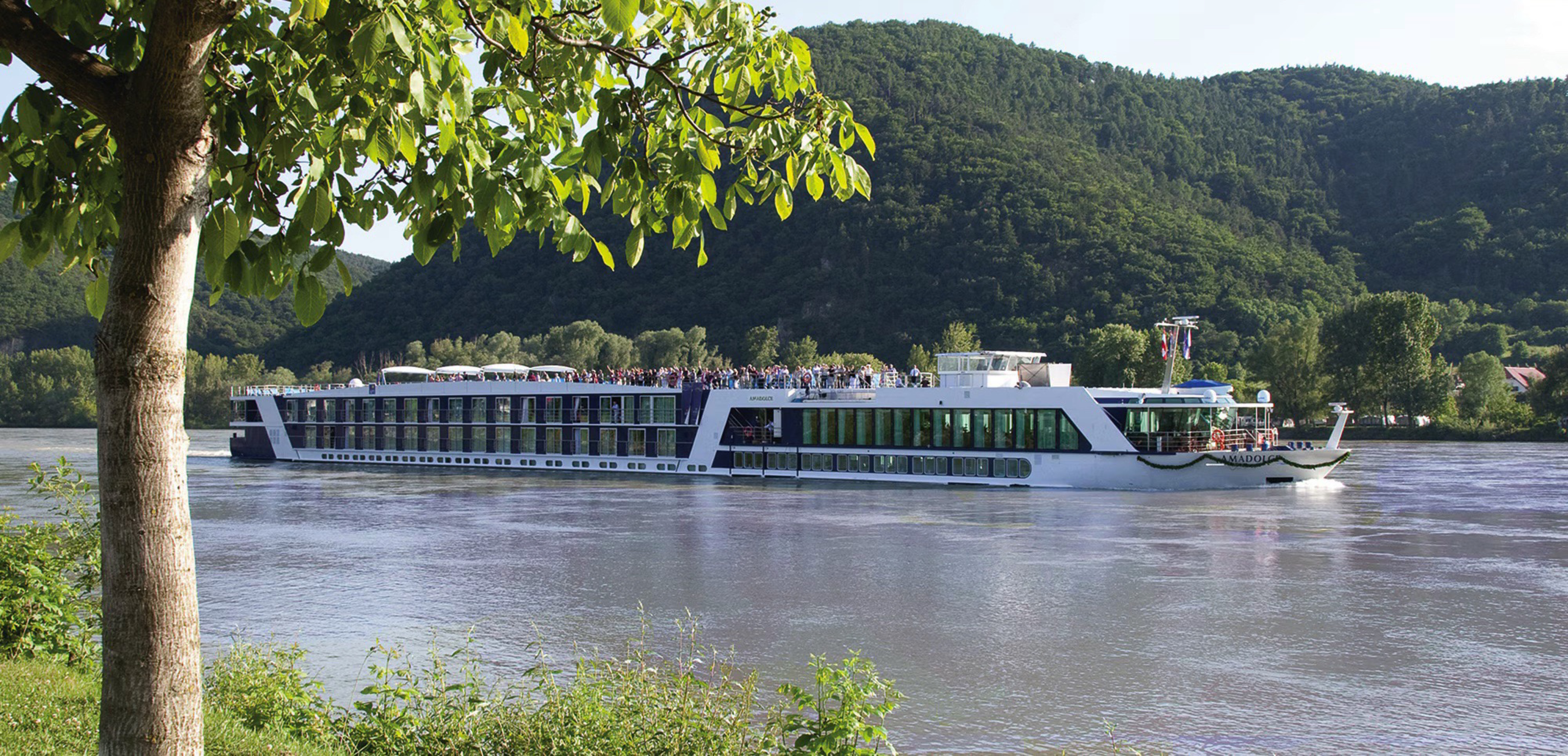Itinerary
Bordeaux as a whole, rather than any particular points within it, is what you’ll want to visit in order to understand why Victor Hugo described it as Versailles plus Antwerp, and why the painter Francisco de Goya, when exiled from his native Spain, chose it as his last home (he died here in 1828). The capital of southwest France and the region’s largest city, Bordeaux remains synonymous with the wine trade: wine shippers have long maintained their headquarters along the banks of the Garonne, while buyers from around the world arrive for the huge biennial Vinexpo show (held in odd-number years).Bordeaux is, admittedly, a less exuberant city than many others in France, but lively and stylish elements are making a dent in its conservative veneer. The cleaned-up riverfront is said by some, after a bottle or two, to exude an elegance reminiscent of St. Petersburg, and that aura of 18th-century élan also permeates the historic downtown sector—“le vieux Bordeaux”—where fine shops invite exploration. To the south of the city center are old docklands undergoing renewal—one train station has now been transformed into a big multiplex movie theater—but the area is still a bit shady. To get a feel for the historic port of Bordeaux, take the 90-minute boat trip that leaves Quai Louis-XVIII every weekday afternoon, or the regular passenger ferry that plies the Garonne between Quai Richelieu and the Pont d’Aquitaine in summer. A nice time to stroll around the city center is the first Sunday of the month, when it’s pedestrian-only and vehicles are banned.
Day programme:
BORDEAUX – EMBARKATION. Embark the ship for your Taste of Bordeaux cruise. (D)
Libourne, France, is a historic town in the Bordeaux wine region, renowned for its vibrant market and beautiful architecture. Located along the Dordogne River, it features a charming blend of medieval and Renaissance buildings, including the striking Church of Saint-Jean-Baptiste. Libourne is a gateway to prestigious wine estates, including Pomerol and Saint-Émilion. The town’s bustling market and scenic riverside setting offer a delightful experience for visitors interested in wine, history, and local culture.
Day programme:
LIBOURNE. Welcome to Libourne, a gateway to one of Bordeaux’s most elite wine regions. Join an excursion to Saint Émilion, known for its celebrated vineyards, and while here, explore the monolithic church carved out of one piece of limestone rock, and then go under the church to discover its catacombs and caves. Afterwards, enjoy a Grand Cru Classé wine tasting at either Château de Ferrand or Château de Pressac. Alternately, you can enjoy an excursion to Saint-Émilion solely to discover more of the small historic town. If you prefer a more active adventure, pedal through the vineyard-rich countryside to Saint-Émilion. (B,L,D)
Libourne, France, is a historic town in the Bordeaux wine region, renowned for its vibrant market and beautiful architecture. Located along the Dordogne River, it features a charming blend of medieval and Renaissance buildings, including the striking Church of Saint-Jean-Baptiste. Libourne is a gateway to prestigious wine estates, including Pomerol and Saint-Émilion. The town’s bustling market and scenic riverside setting offer a delightful experience for visitors interested in wine, history, and local culture.
Day programme:
LIBOURNE – BLAYE. Stroll through the colorful, open-air market, tasting some of the region’s specialties. As a unique alternative, travel back in time to visit an ancient watermill and learn the tradition of breadmaking. Or, you can get your heart pumping by venturing deeper into town by hiking through one of Libourne’s renowned vineyards, accompanied by a tasting of local wine and tapas. (B,L,D)
Blaye, France, is a picturesque town in the Gironde department, renowned for its historic Blaye Citadel, a UNESCO World Heritage site with stunning views of the Gironde estuary. The town boasts charming streets, vibrant markets, and renowned vineyards producing exceptional wines, including Blaye Côtes de Bordeaux. Blaye’s blend of historical architecture, scenic river views, and local wine culture makes it an inviting destination for history enthusiasts and wine lovers alike.
Day programme:
BLAYE – BOURG. Once in Blaye, you can join a tour of its 17th-century citadel, a UNESCO World Heritage Site. For a more active excursion, take a bike ride around Blaye along a former railway. Later in the day, in the ancient village of Bourg, take a walking tour and visit the Carriage Museum, which houses a wonderful collection of horse-drawn vehicles, and the World War II Petrol Cistern. Towards the evening, experience the hospitality of this charming medieval village with an exclusive wine festival. Meet the local wine growers and taste the fruits of their labors as well as enjoy live French music and dancing. (B,L,D)
Pauillac, France, is a scenic village in the Bordeaux wine region, renowned for its prestigious vineyards and charming riverfront. Located on the Gironde estuary, it is famed for its high-quality red wines, including those from renowned châteaux like Lafite Rothschild and Mouton Rothschild. The village features historic buildings, vibrant markets, and stunning views of the estuary. Pauillac’s blend of rich winemaking heritage and picturesque landscapes makes it a delightful destination for wine enthusiasts and travellers seeking a taste of Bordeaux’s elegance.
Day programme:
PAUILLAC. Today, you can join a tour of the Médoc region’s renowned wine estates and savor a tasting of Grand Cru wines. More active guests can hike through the vineyards, followed by a tasting of local specialties. (B,L,D)
Cadillac, France, is a charming town in the Gironde department, known for its historic architecture and vineyards. Famous for its production of sweet white wines, especially Cadillac Côtes de Bordeaux, the town features a well-preserved 18th-century château and picturesque streets. Set along the Garonne River, Cadillac offers scenic views and a rich heritage, blending historical charm with local wine culture. Its vibrant markets and serene atmosphere make it a pleasant destination for those exploring the Bordeaux wine region.
Day programme:
CADILLAC. Visit the impressive Castle of Roquetaillade, an amazingly preserved masterpiece of medieval military architecture owned by the same noble family for 700 years and travel to the Sauternes wine region to either Chateau de Rayne Vigneau or Château Guiraud to taste the highly prized golden-hued sweet wines produced here. For those wishing to explore more of the history on the decadent castles, you can enjoy a visit to the Roquetaillade castle and Cadillac castle. Or, pedal through the charming town of Cadillac for a guided bike tour. (B,L,D)
Bordeaux as a whole, rather than any particular points within it, is what you’ll want to visit in order to understand why Victor Hugo described it as Versailles plus Antwerp, and why the painter Francisco de Goya, when exiled from his native Spain, chose it as his last home (he died here in 1828). The capital of southwest France and the region’s largest city, Bordeaux remains synonymous with the wine trade: wine shippers have long maintained their headquarters along the banks of the Garonne, while buyers from around the world arrive for the huge biennial Vinexpo show (held in odd-number years).Bordeaux is, admittedly, a less exuberant city than many others in France, but lively and stylish elements are making a dent in its conservative veneer. The cleaned-up riverfront is said by some, after a bottle or two, to exude an elegance reminiscent of St. Petersburg, and that aura of 18th-century élan also permeates the historic downtown sector—“le vieux Bordeaux”—where fine shops invite exploration. To the south of the city center are old docklands undergoing renewal—one train station has now been transformed into a big multiplex movie theater—but the area is still a bit shady. To get a feel for the historic port of Bordeaux, take the 90-minute boat trip that leaves Quai Louis-XVIII every weekday afternoon, or the regular passenger ferry that plies the Garonne between Quai Richelieu and the Pont d’Aquitaine in summer. A nice time to stroll around the city center is the first Sunday of the month, when it’s pedestrian-only and vehicles are banned.
Day programme:
BORDEAUX. The breathtaking capital of the wine world, Bordeaux is a UNESCO World Heritage Site and classified as a “City of Art and History.” During your time here, you will also experience Bordeaux’s famous Christmas Markets and be immersed in the warm holiday atmosphere in this vibrant city. You’ll also have an opportunity to experience much of the rich culture and architecture on a city tour followed by a visit to the famed indoor Les Halles de Bacalan market for a tasting of local specialties to please the palate. Bike enthusiasts will wish to join a tour along the city’s amazing network of bicycle paths. Depending on your interests, you have a choice from three excursions in the afternoon. Enjoy a visit to the immersive and interactive Bordeaux Wine Museum, housed in an awe-inspiring building. Alternately, be treated to a spectacular sound and light show, Les Bassins des Lumières. (B,L,D)
Bordeaux as a whole, rather than any particular points within it, is what you’ll want to visit in order to understand why Victor Hugo described it as Versailles plus Antwerp, and why the painter Francisco de Goya, when exiled from his native Spain, chose it as his last home (he died here in 1828). The capital of southwest France and the region’s largest city, Bordeaux remains synonymous with the wine trade: wine shippers have long maintained their headquarters along the banks of the Garonne, while buyers from around the world arrive for the huge biennial Vinexpo show (held in odd-number years).Bordeaux is, admittedly, a less exuberant city than many others in France, but lively and stylish elements are making a dent in its conservative veneer. The cleaned-up riverfront is said by some, after a bottle or two, to exude an elegance reminiscent of St. Petersburg, and that aura of 18th-century élan also permeates the historic downtown sector—“le vieux Bordeaux”—where fine shops invite exploration. To the south of the city center are old docklands undergoing renewal—one train station has now been transformed into a big multiplex movie theater—but the area is still a bit shady. To get a feel for the historic port of Bordeaux, take the 90-minute boat trip that leaves Quai Louis-XVIII every weekday afternoon, or the regular passenger ferry that plies the Garonne between Quai Richelieu and the Pont d’Aquitaine in summer. A nice time to stroll around the city center is the first Sunday of the month, when it’s pedestrian-only and vehicles are banned.
Day programme:
BORDEAUX – DISEMBARKATION. Disembark the ship and prepare for your flight home. (B)
Ship features
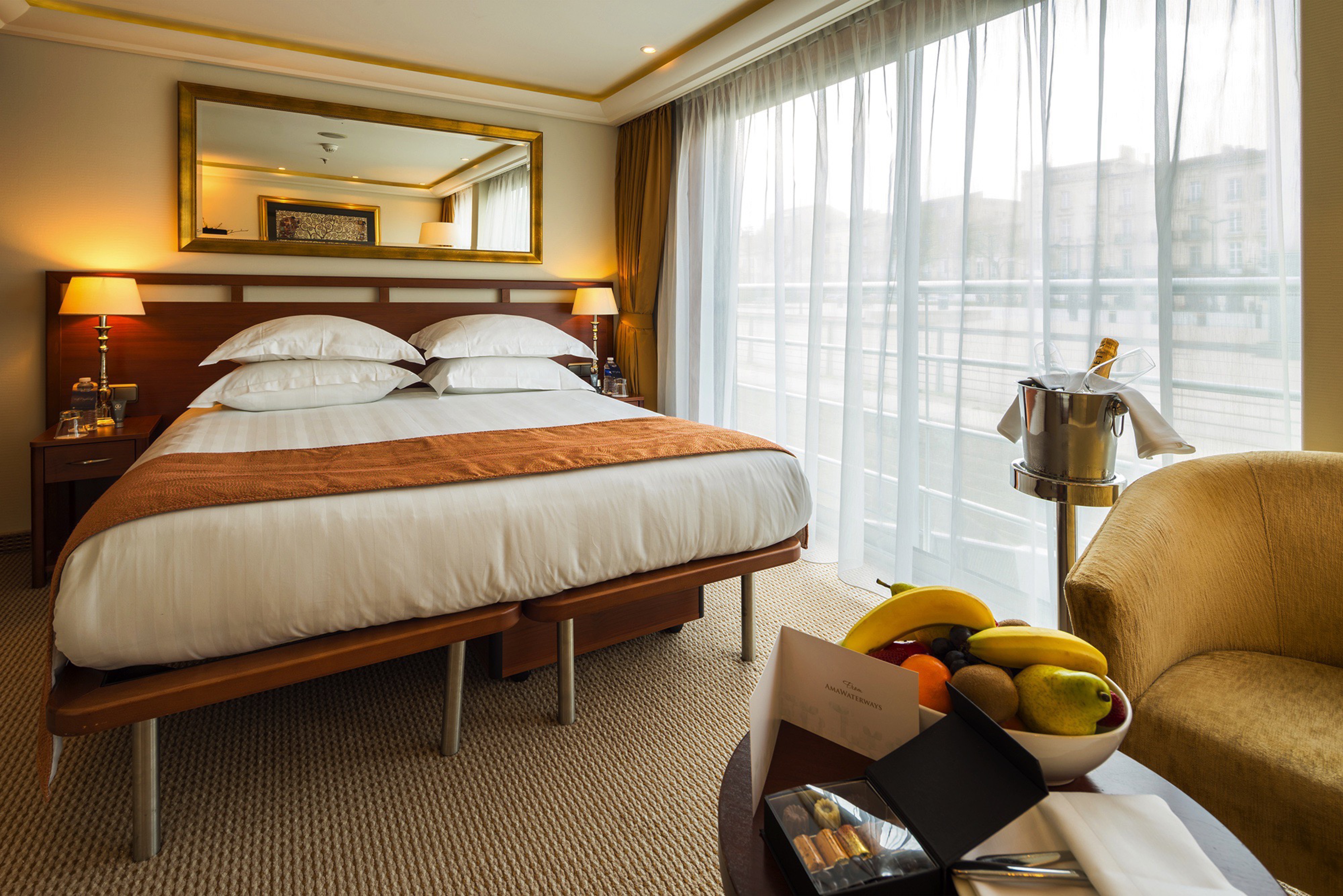
Suite
Stateroom Features:
- In-room temperature control
- Deluxe hotel-style bedding with Egyptian linen, down pillows and duvet
- Spacious bathrooms with multi-jet showerheads
- Large wardrobe, full-length mirror, hair dryer, safe and direct-dial telephone
- Flat-screen TV that also works as a computer
- Entertainment on Demand system providing complimentary TV, movies and music library
- Complimentary internet and Wi-Fi
- Complimentary bottled water replenished daily
- Desk and chair
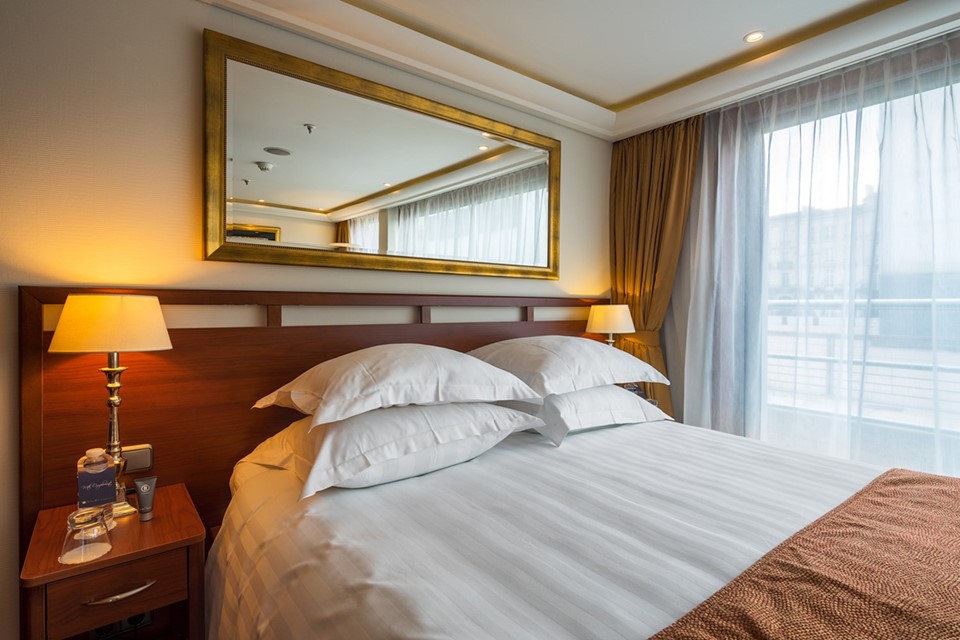
Cat A+
Stateroom Features:
- In-room temperature control
- Deluxe hotel-style bedding with Egyptian linen, down pillows and duvet
- Spacious bathrooms with multi-jet showerheads
- Large wardrobe, full-length mirror, hair dryer, safe and direct-dial telephone
- Flat-screen TV that also works as a computer
- Entertainment on Demand system providing complimentary TV, movies and music library
- Complimentary internet and Wi-Fi
- Complimentary bottled water replenished daily
- Desk and chair
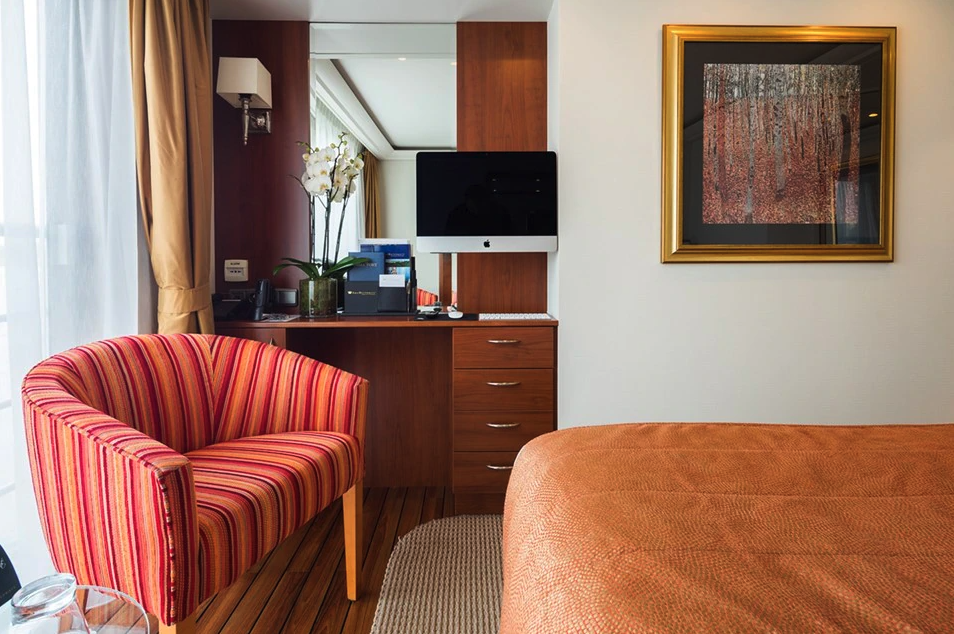
Category A Stateroom
Stateroom Features:
- In-room temperature control
- Deluxe hotel-style bedding with Egyptian linen, down pillows and duvet
- Spacious bathrooms with multi-jet showerheads
- Large wardrobe, full-length mirror, hair dryer, safe and direct-dial telephone
- Flat-screen TV that also works as a computer
- Entertainment on Demand system providing complimentary TV, movies and music library
- Complimentary internet and Wi-Fi
- Complimentary bottled water replenished daily
- Desk and chair
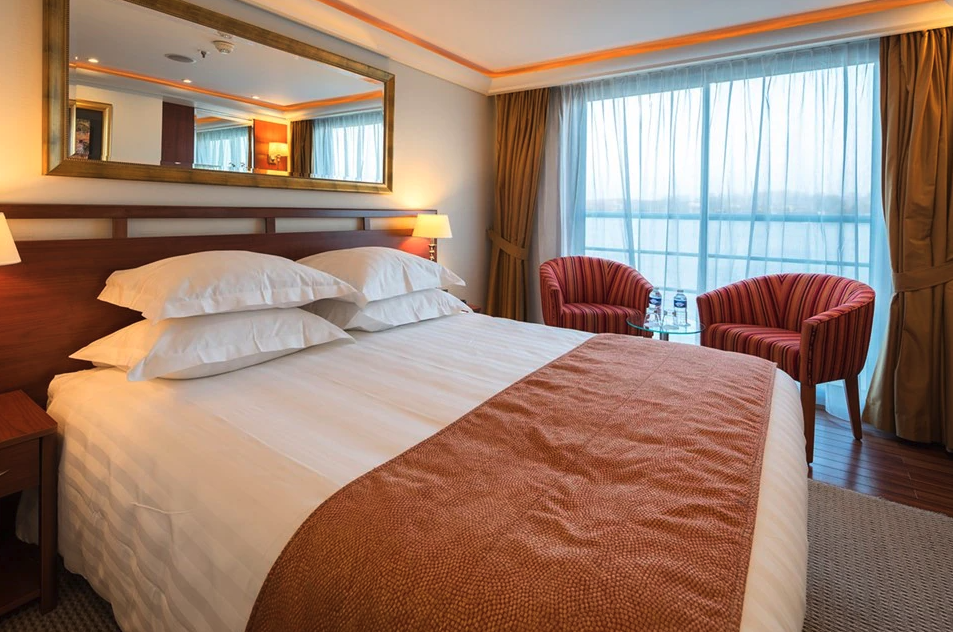
Category B Stateroom
Stateroom Features:
- In-room temperature control
- Deluxe hotel-style bedding with Egyptian linen, down pillows and duvet
- Spacious bathrooms with multi-jet showerheads
- Large wardrobe, full-length mirror, hair dryer, safe and direct-dial telephone
- Flat-screen TV that also works as a computer
- Entertainment on Demand system providing complimentary TV, movies and music library
- Complimentary internet and Wi-Fi
- Complimentary bottled water replenished daily
- Desk and chair
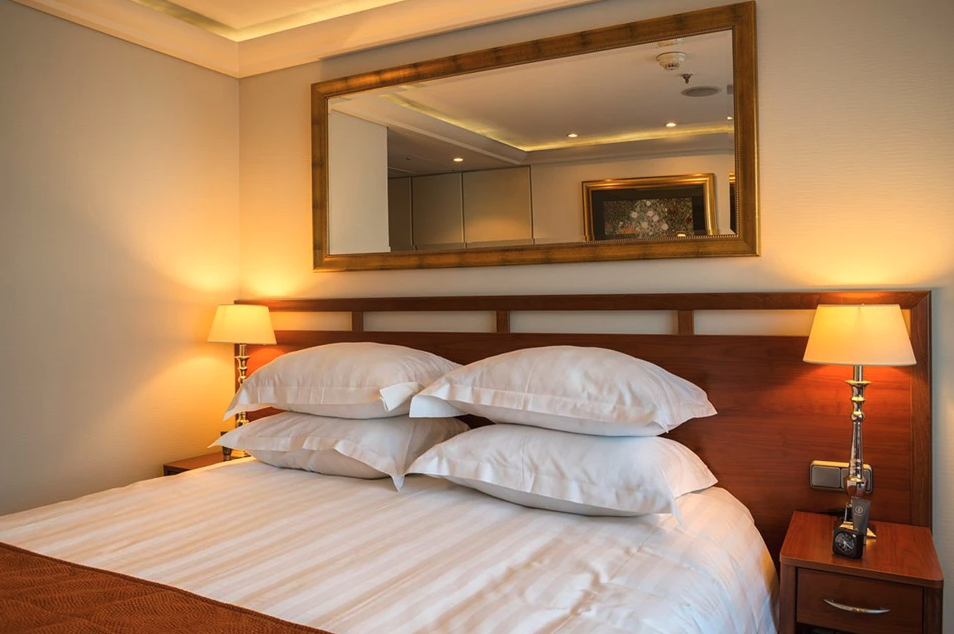
Category C Stateroom
Stateroom Features:
- In-room temperature control
- Deluxe hotel-style bedding with Egyptian linen, down pillows and duvet
- Spacious bathrooms with multi-jet showerheads
- Large wardrobe, full-length mirror, hair dryer, safe and direct-dial telephone
- Flat-screen TV that also works as a computer
- Entertainment on Demand system providing complimentary TV, movies and music library
- Complimentary internet and Wi-Fi
- Complimentary bottled water replenished daily
- Desk and chair
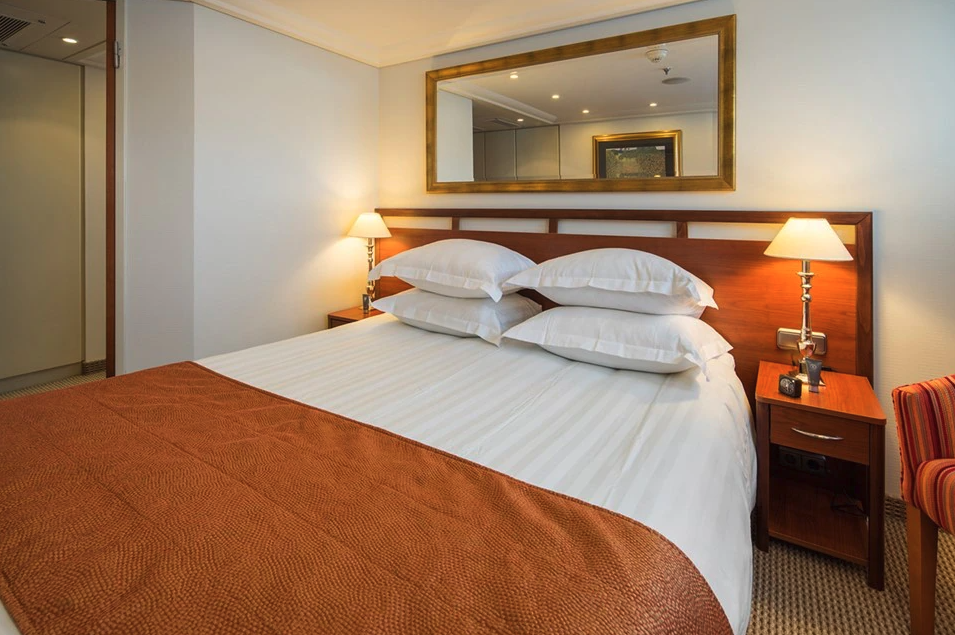
Category D Staterooms
Stateroom Features
- In-room temperature control
- Deluxe hotel-style bedding with Egyptian linen, down pillows and duvet
- Spacious bathrooms with multi-jet showerheads
- Large wardrobe, full-length mirror, hair dryer, safe and direct-dial telephone
- Flat-screen TV
- Entertainment on Demand system providing complimentary TV, movies and music library
- Complimentary internet and Wi-Fi
- Complimentary bottled water replenished daily
- Desk and chair
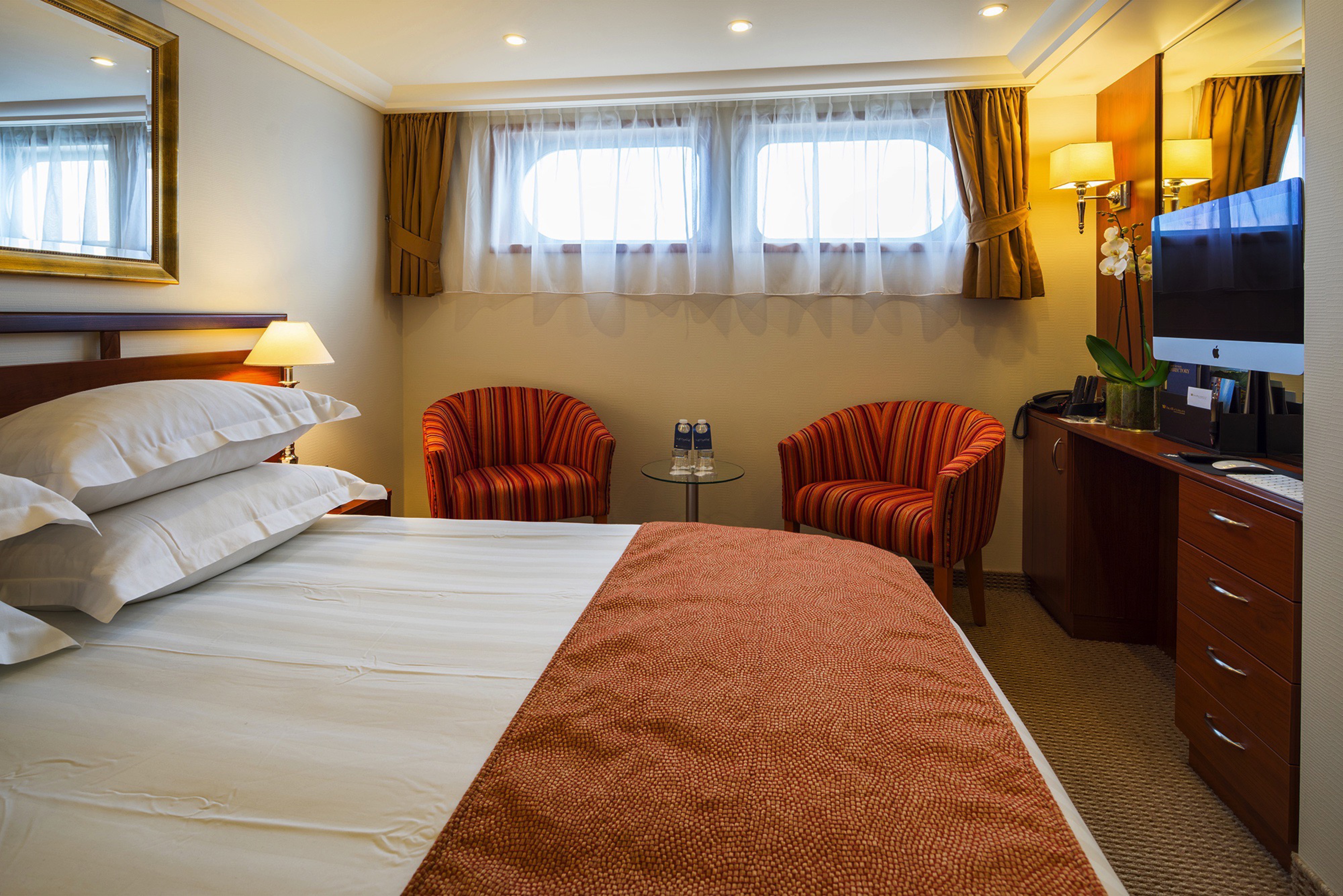
Category E Staterooms
Stateroom Features
- In-room temperature control
- Deluxe hotel-style bedding with Egyptian linen, down pillows and duvet
- Spacious bathrooms with multi-jet showerheads
- Large wardrobe, full-length mirror, hair dryer, safe and direct-dial telephone
- Flat-screen TV
- Entertainment on Demand system providing complimentary TV, movies and music library
- Complimentary internet and Wi-Fi
- Complimentary bottled water replenished daily
- Desk and chair
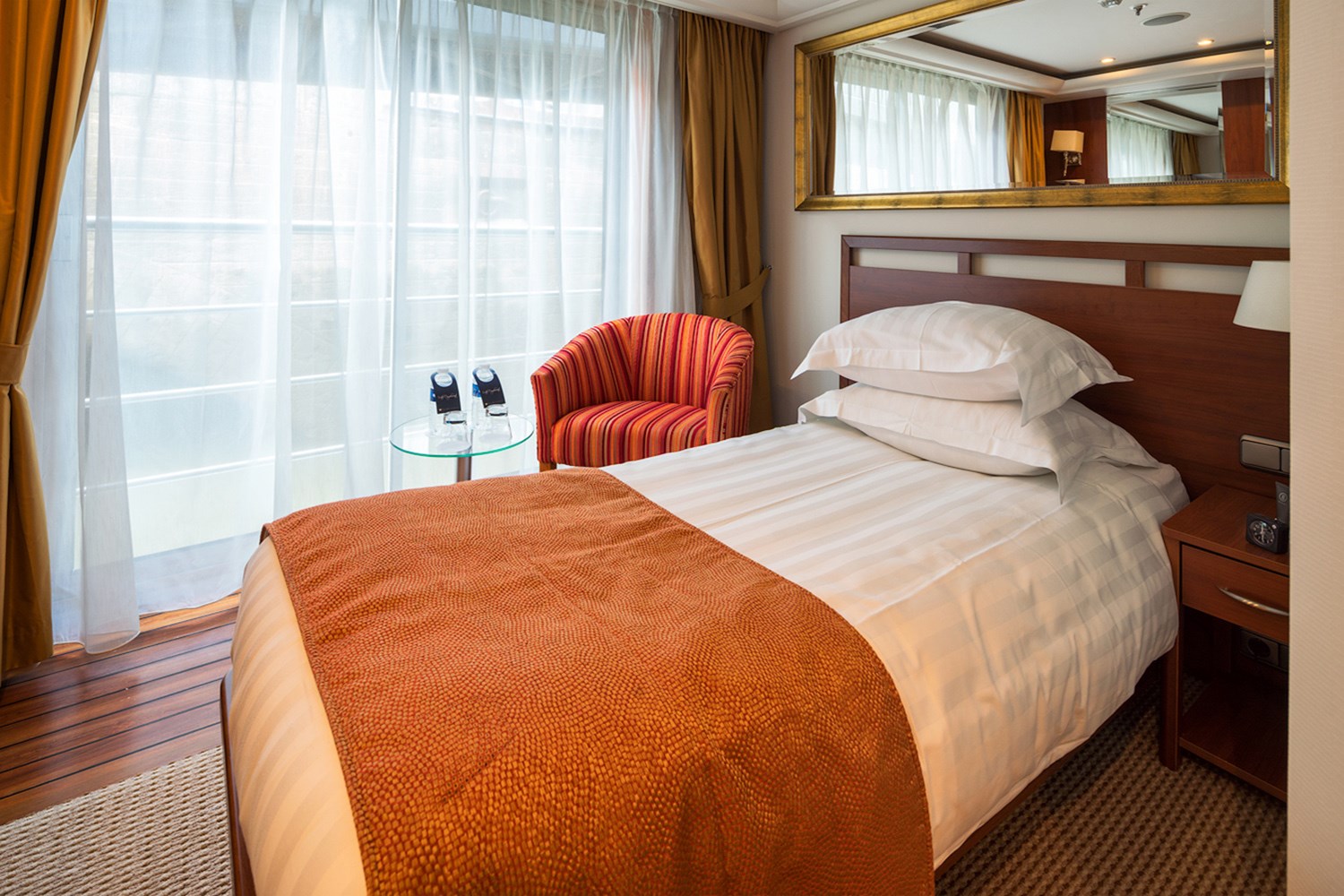
Single Suite
Stateroom Features
- In-room temperature control
- Deluxe hotel-style bedding with Egyptian linen, down pillows and duvet
- Spacious bathrooms with multi-jet showerheads
- Large wardrobe, full-length mirror, hair dryer, safe and direct-dial telephone
- Flat-screen TV
- Entertainment on Demand system providing complimentary TV, movies and music library
- Complimentary internet and Wi-Fi
- Complimentary bottled water replenished daily
- Desk and chair
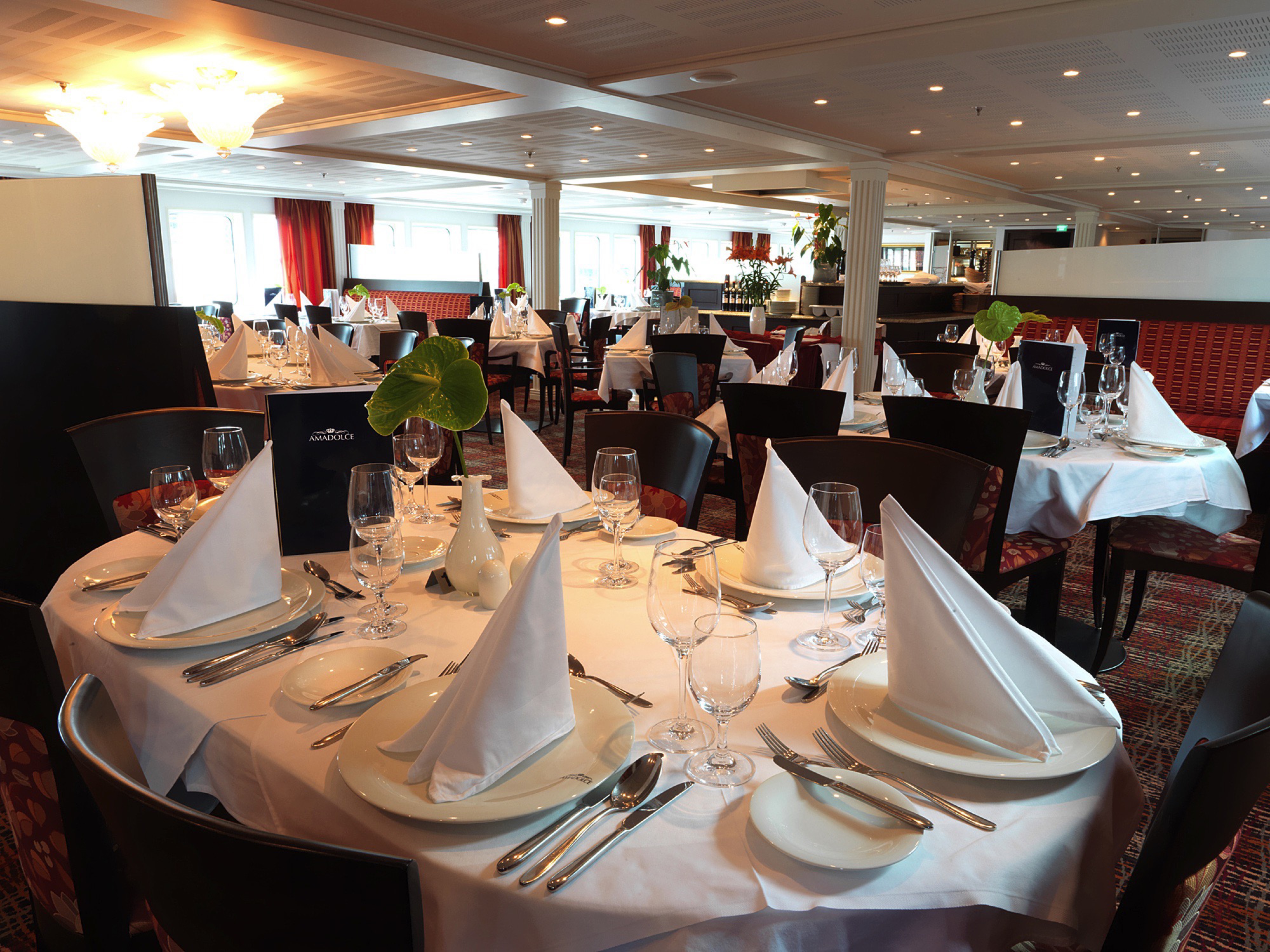
Main Restaurant
AmaWaterways’ expert chefs craft menus that feature exquisite, locally-inspired cuisine as well as traditional, Western offerings. At breakfast, sip sparkling wine as you partake fresh pastries, or opt for something made-to-order from the menu. Stop by the Main Lounge for a light lunch, or head to the restaurant for full menu service and high-quality regional wine or beer. Dinner is a delectable, multi-course affair with wine recommendations that accompany visually stunning, delicious dishes. Try local favourites — like goulash while cruising through Hungary, bratwurst and sauerkraut after returning to the ship from Vienna, or Camembert cheese while on the Seine — or something more familiar, like a sandwich. No matter what your preference, your taste buds are sure to be impressed.
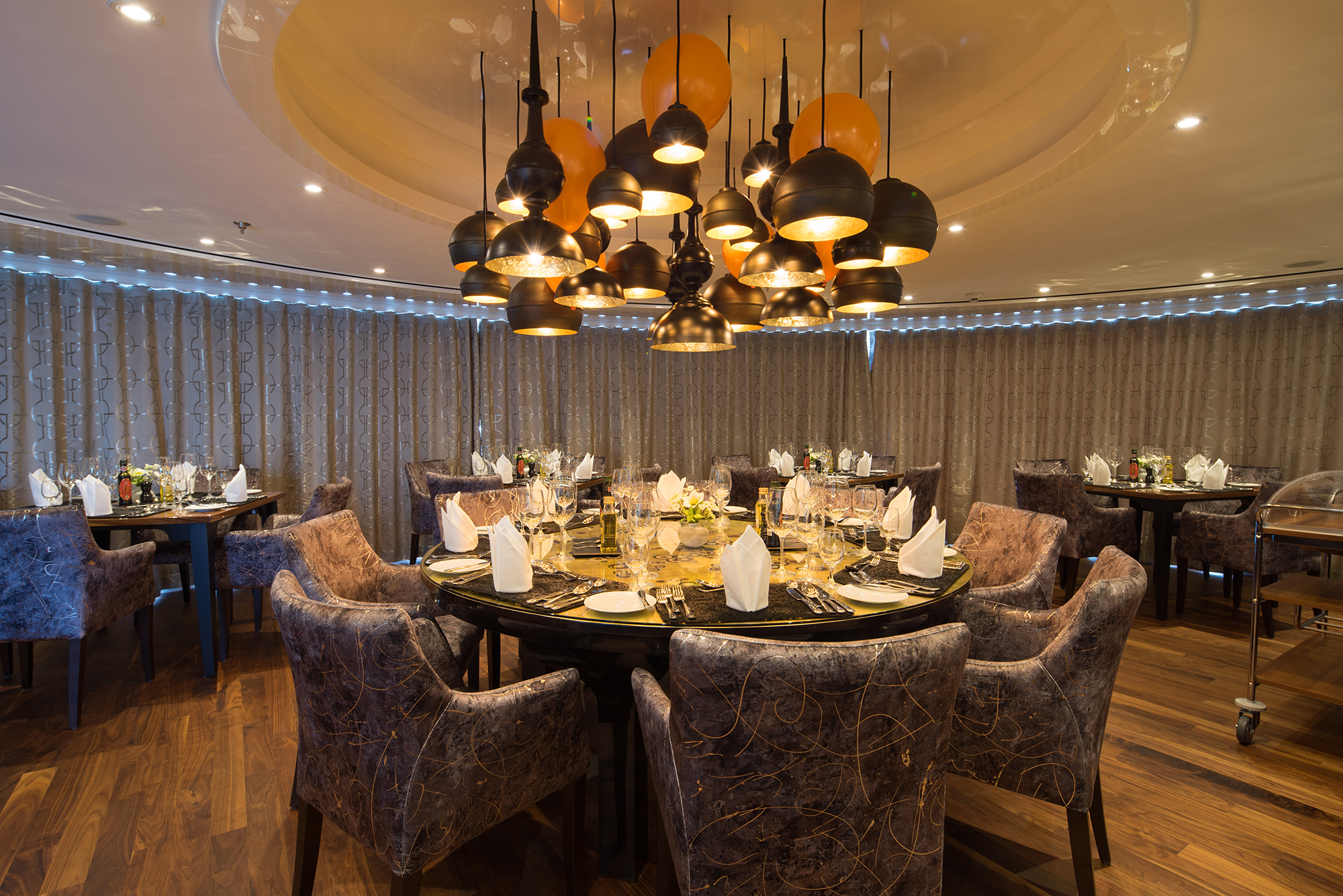
The Chef’s Table
Join a few of your fellow travellers at The Chef’s Table, where the kitchen — usually hidden — becomes part of the entertainment. You’ll have the opportunity to watch the chef prepare a special multi-course meal right in front of you. The menu here is unique, making this a truly distinct gastronomic experience. Indulge in delectable dishes served with unlimited fine wines, hand-selected just for this dinner. It is the only venue of its kind on the river.
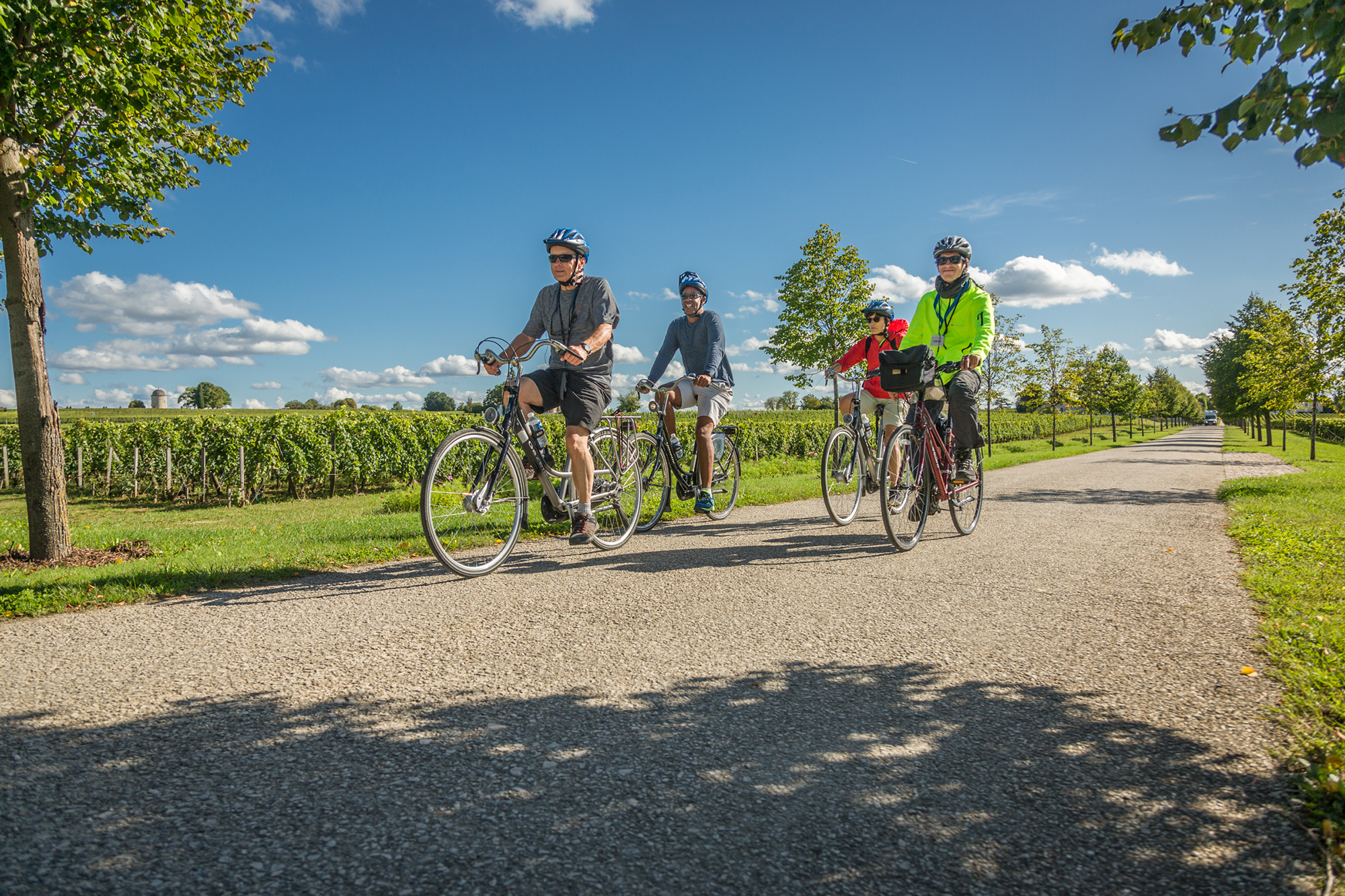
Guided Bike Tours
With AmaWaterways, you have the option of exploring Europe’s amazing sights like the locals do. We were the first river cruise line to carry an entire fleet of complimentary bicycles on board, so you can experience biking alongside enchanting riverside pathways and in city centres. Whether you feel like joining one of our exclusive guided bike tours, or want to go discover on your own, there are many ways for you to explore on two wheels during your cruise. Here are a few examples:
- Bike along the beautiful Danube River between Dürnstein and Melk in Austria’s Wachau Valley
- Tour Cologne’s Old Town and Cathedral along the Rhine River
- See the medieval city of Rouen in France’s historic Normandy region, near the Seine River
- Take in wooded hills and beaches of poplars along the scenic shores of the Inn River in Passau
- Go on a guided bike ride in Vienna, where you’ll visit Klosterneuberg Abbey and enjoy cake and coffee
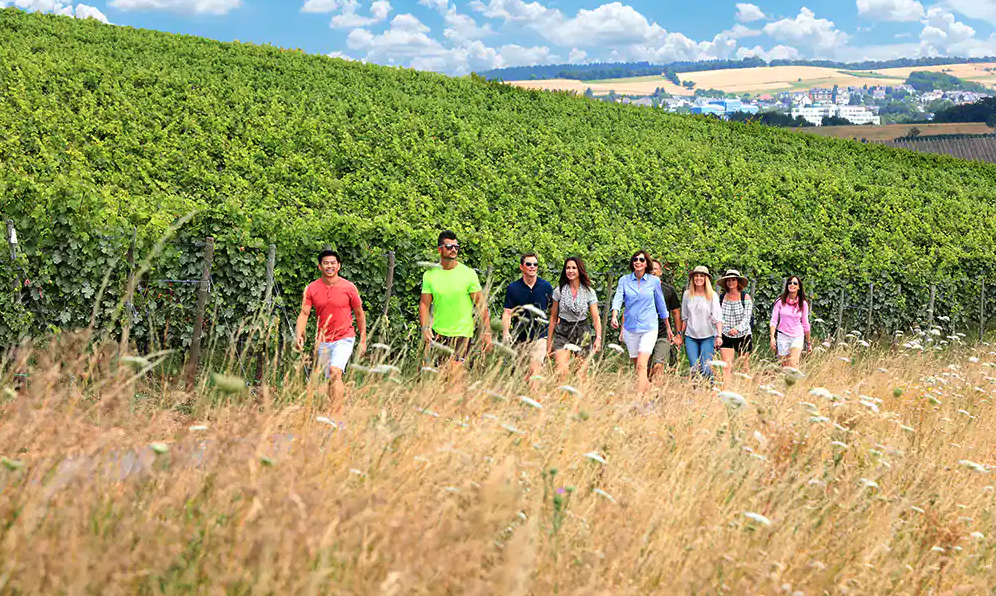
Guided Hiking Tours
The beauty of Europe doesn’t just lie in its architecture and landmarks – there are also breath taking things to be seen when you venture out into nature. That’s why we’ve designed special hikes that will take you a bit off the beaten path in some very beautiful destinations.
- Trek up to the Veste Oberhaus in Passau, Germany for incredible views over Old Passau
- Make your way up to Dürnstein Fortress, where it is said that Richard the Lionheart was once held captive
- Hike up the Philosopher’s Path to a panoramic view of Heidelberg and the Necker River
- Journey from the ship to the Old Town in Strasbourg, France
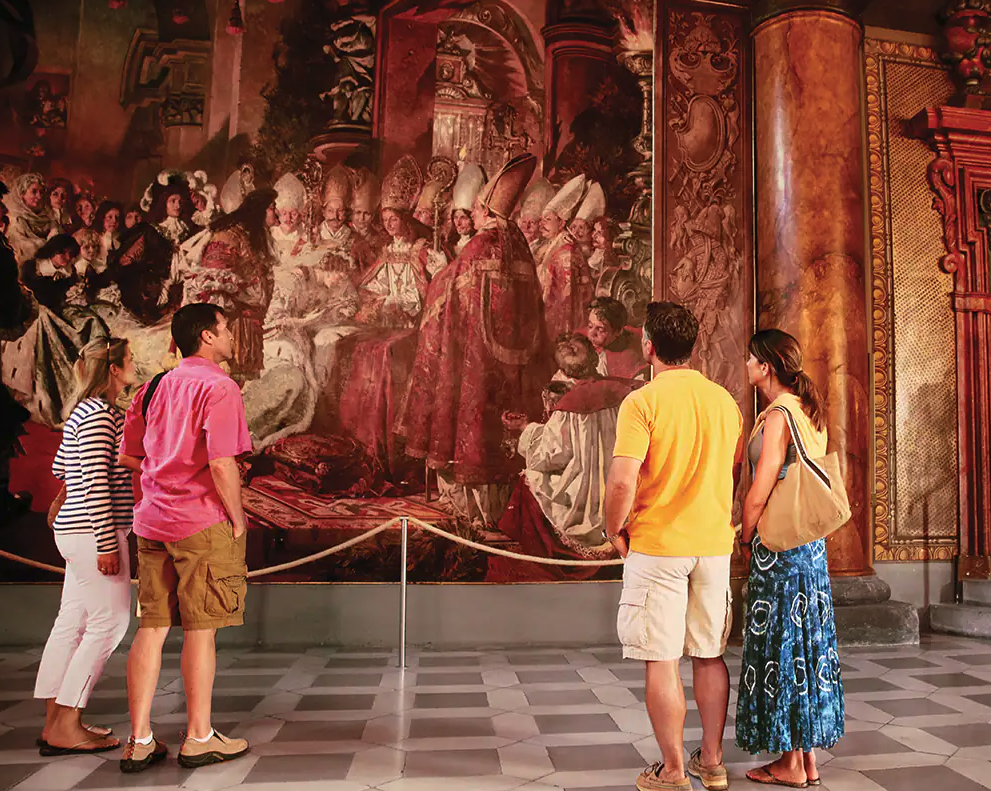
Included Tours
We realise that our guests have different tastes, so we’ve developed a menu of shore excursions in every port of call. In many destinations, you’ll be free to choose from one of several options — all of which are included in your cruise fare. There’s always a city tour designed to show you all the renowned highlights and landmarks in grand capitals and charming villages alike. Is it your first time in Vienna? Opt for an unforgettable exploration of the major sights led by a local, English-speaking guide that is well versed in history and culture. Have you already been to Nuremberg? Instead of taking the city tour, indulge in a bratwurst and beer tasting on one of our Special Interest Tours, which are specially designed to place you in the midst of local life. Are you looking for something more active? See the beautiful scenery of Austria’s Wachau Valley with a guided bike tour along the Danube. The choice is yours.
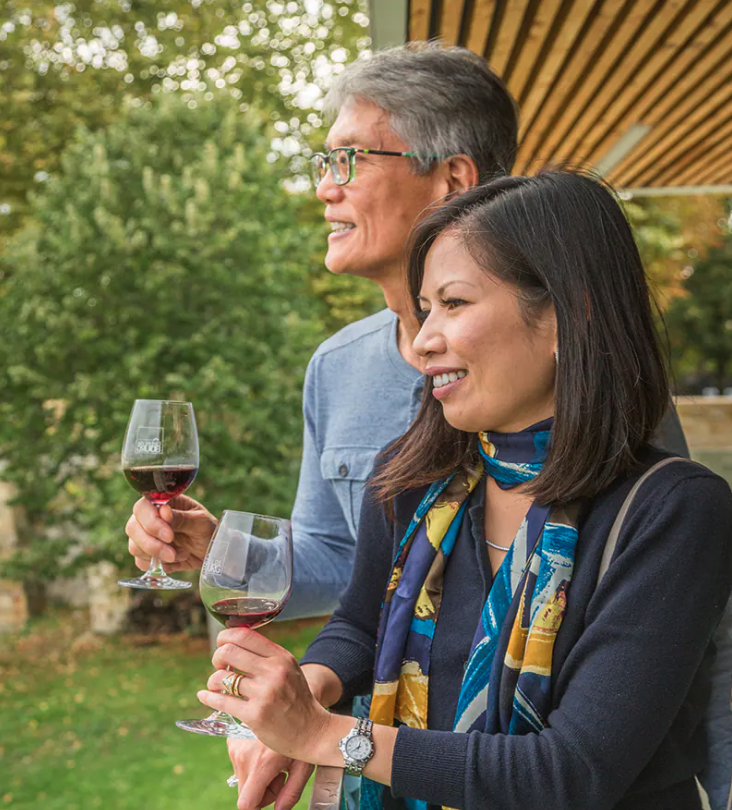
Limited Edition Tours
Every year, we seek out new opportunities for our guests to experience local culture in a unique way. These tours are specially designed to give small groups the chance to be even more immersed in a destination. Here are just a few examples:
- Indulge in authentic Belgian waffles and chocolate in Antwerp
- Try your hand at knotting a bretzel (German for “pretzel”) in Wertheim
- Go to a bratwurst and beer tasting at the oldest brewery in Nuremberg
- Discover hidden treasures on a tour of Vienna’s secret spots and sights
- Sample Bavarian specialties like pralines in Regensburg

Land Packages
Make the most of your long-awaited vacation by adding our optional land packages before or after your sailing for an all-encompassing river cruise and land journey. Indulge your wanderlust and we’ll whisk you away between your ship and hotel, plus take you on specially curated guided tours with just the right amount of leisure time to explore the art, history or culinary delights in sought-after cities around the world.
Why Add a Land Package?
There are many benefits to adding a land package before or after your sailing. One of the simplest reasons is the convenience of making all your future travel plans in one step. Our concierge services allow you to reserve your river cruise, flights, airport transfers and land packages all at once. No need to call and research multiple providers – just contact your travel advisor and we’ll take care of it all. But the value of adding a land package doesn’t stop there.
World-Class Hotels
Whether you wish to rest and recover from flights or pamper yourself before returning home, you’ll find no better respite than the trusted, 4- and 5-star hotels we have carefully selected for you. Each luxurious property is centrally located near the major sights, such as Turkey’s Istanbul at Sultanahmet, just steps from the magnificent Blue Mosque. If you should wish to extend your vacation even further, your travel advisor can conveniently arrange extra hotel nights through AmaWaterways as well.
Our land packages include transfers between your hotel and river cruise ship, portage service and daily breakfast at the hotel. In addition, fascinating guided city tours and excursions are included, so you can:
- Discover breathtaking Mont St. Michel, France, the artistic inspiration for the movie Tangled
- Join a tasting of Czech beer while learning about the beverage’s long and illustrious history
- Visit Transylvania’s infamous Bran Castle, otherwise known as Dracula’s Castle
- Board a boat for a scenic ride along Italy’s Lake Como to the stunning lakeside village of Bellagio
- Rise with the sun at Cambodia’s UNESCO-designated Angkor Archaeological Complex
What’s Included in Your Land Package
- Overnight stays at 4- and 5-star hotels conveniently located near the major sites
- Daily breakfast at the hotel
- Guided city tours
- Convenient transfers to and from the ship
- The services of a professionally trained Cruise Manager throughout your river cruise and land stay – unique in the industry
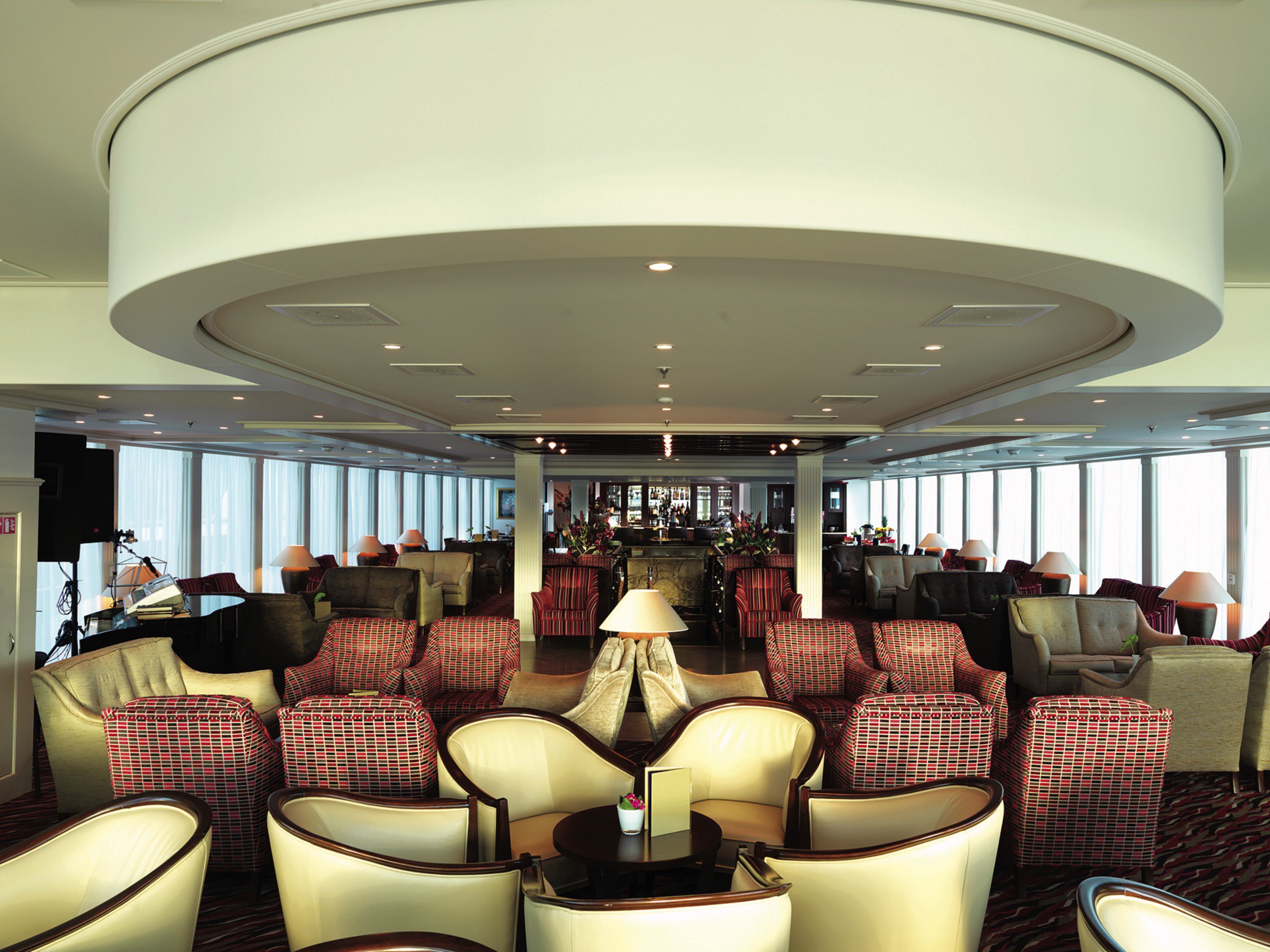
Main Lounge & Bar
This versatile space hosts a bar, dance floor, plenty of comfortable couches and big windows on three sides and is used for everything from the morning port talks, daytime reading and chatting to scenic cruising, afternoon tea and evening entertainment.
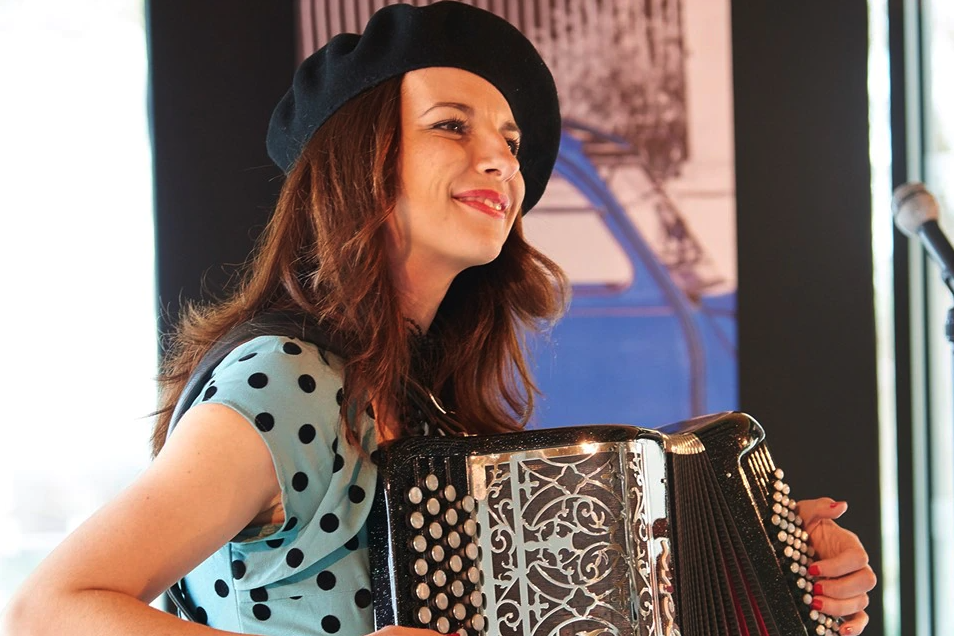
Onboard Entertainment
Whether it’s a folkloric performance, local quartet, serenade of Parisian classics or modern piano favourites, there is an eclectic schedule of entertainment on board.
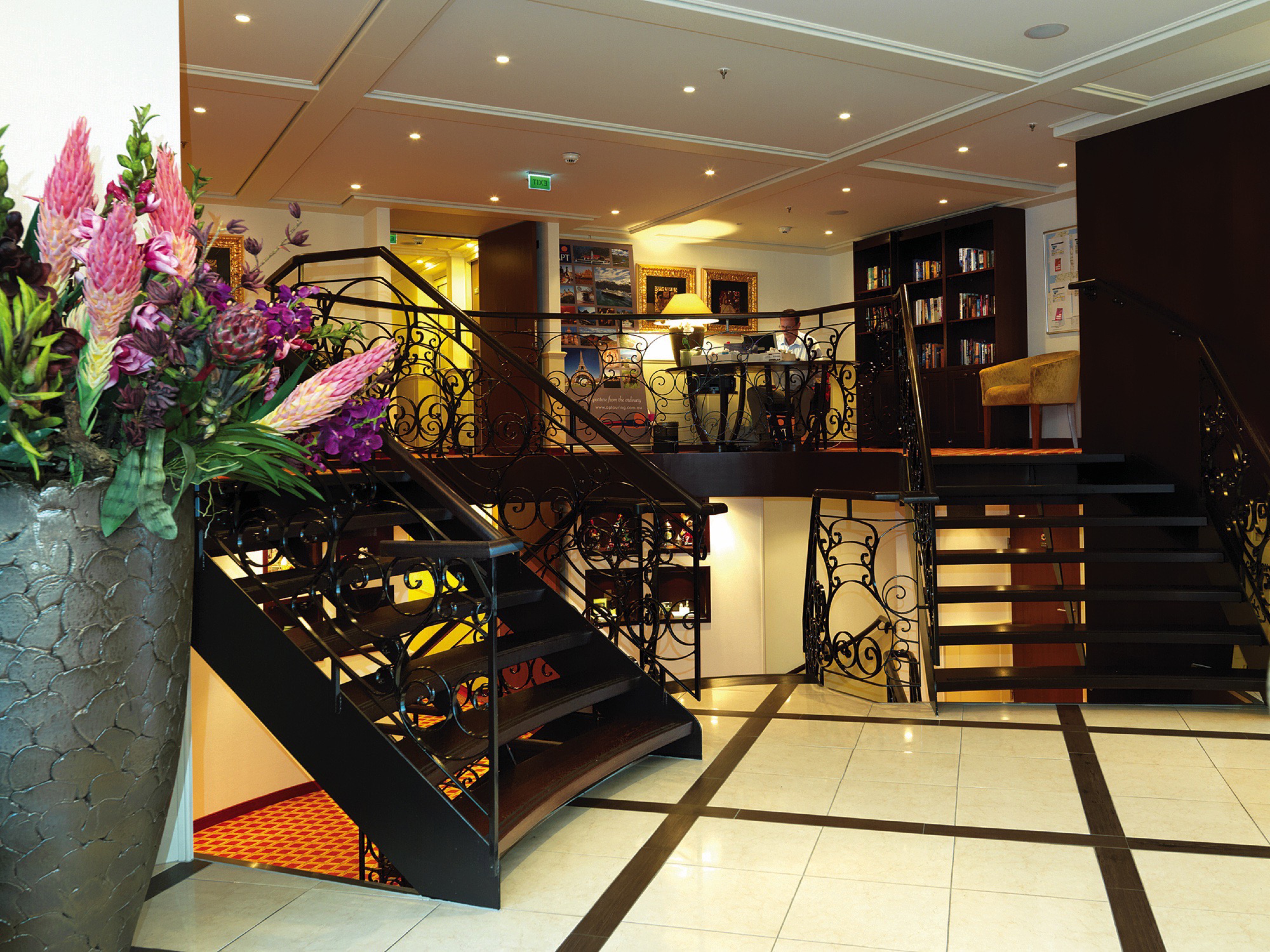
Reception
The Reception can be found on the Violin Deck.
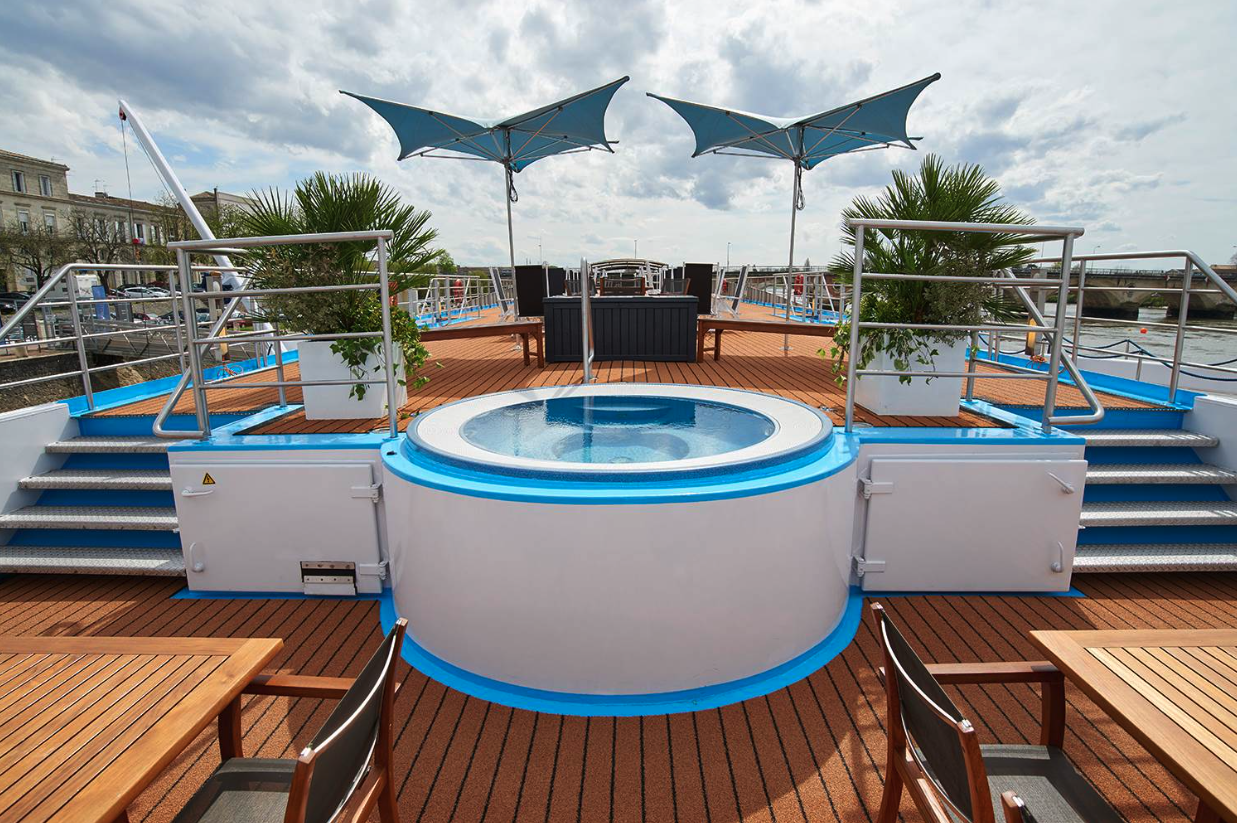
Sun Deck
Soak up some rays or take a dip in our refreshing pool.
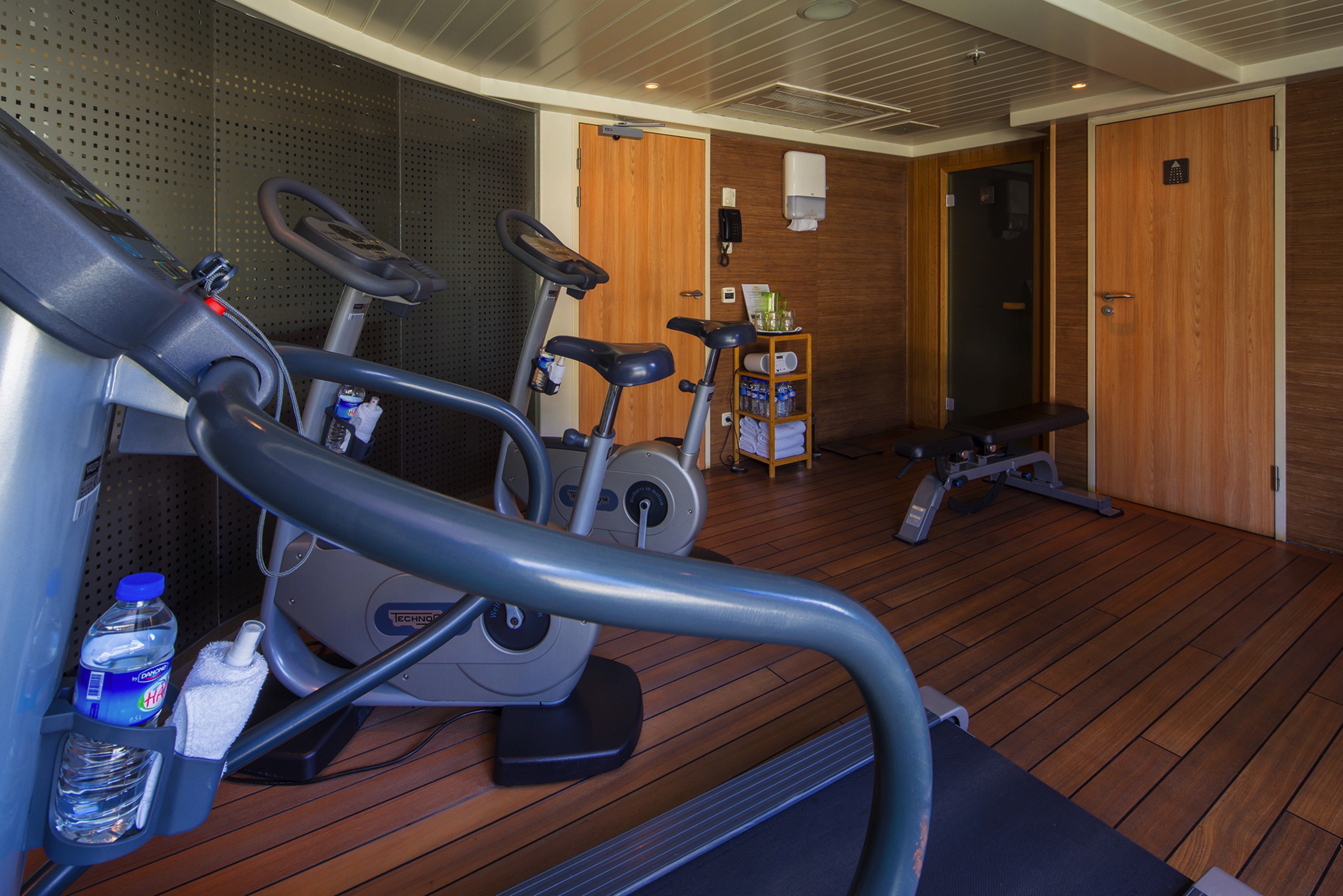
Fitness Room
Are you looking for a way to stay fit on vacation? Hit the treadmill or lift some weights while cruising from one destination to the next.

Sun Deck Whirlpool
Enjoy the whirlpool on the Sun Deck as we pass by centuries-old castles, charming villages and other breathtaking scenery.
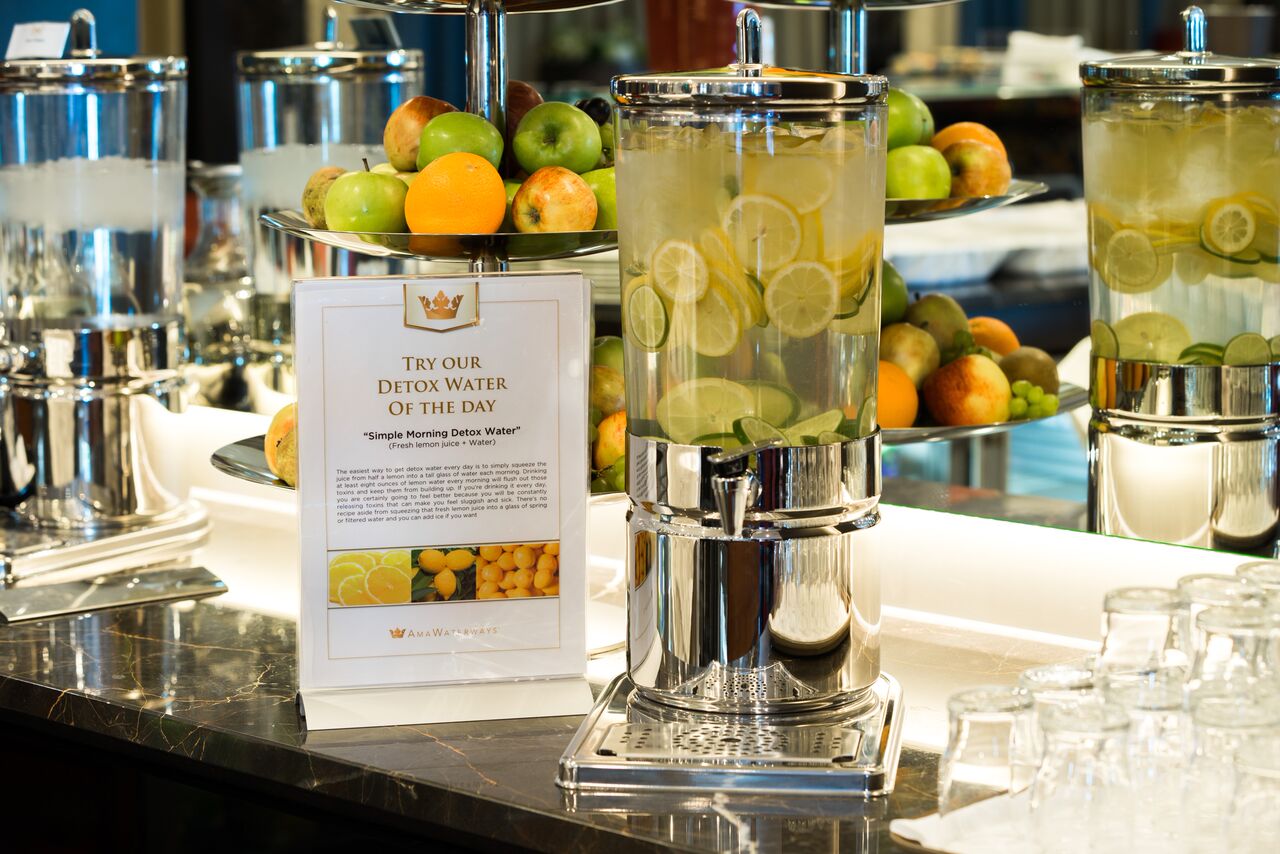
Healthy Options
Lighter options are always available during meals as well as gluten free, vegetarian and low-sodium options. Discover the infused detox and gemstone water at our Hydration Station.
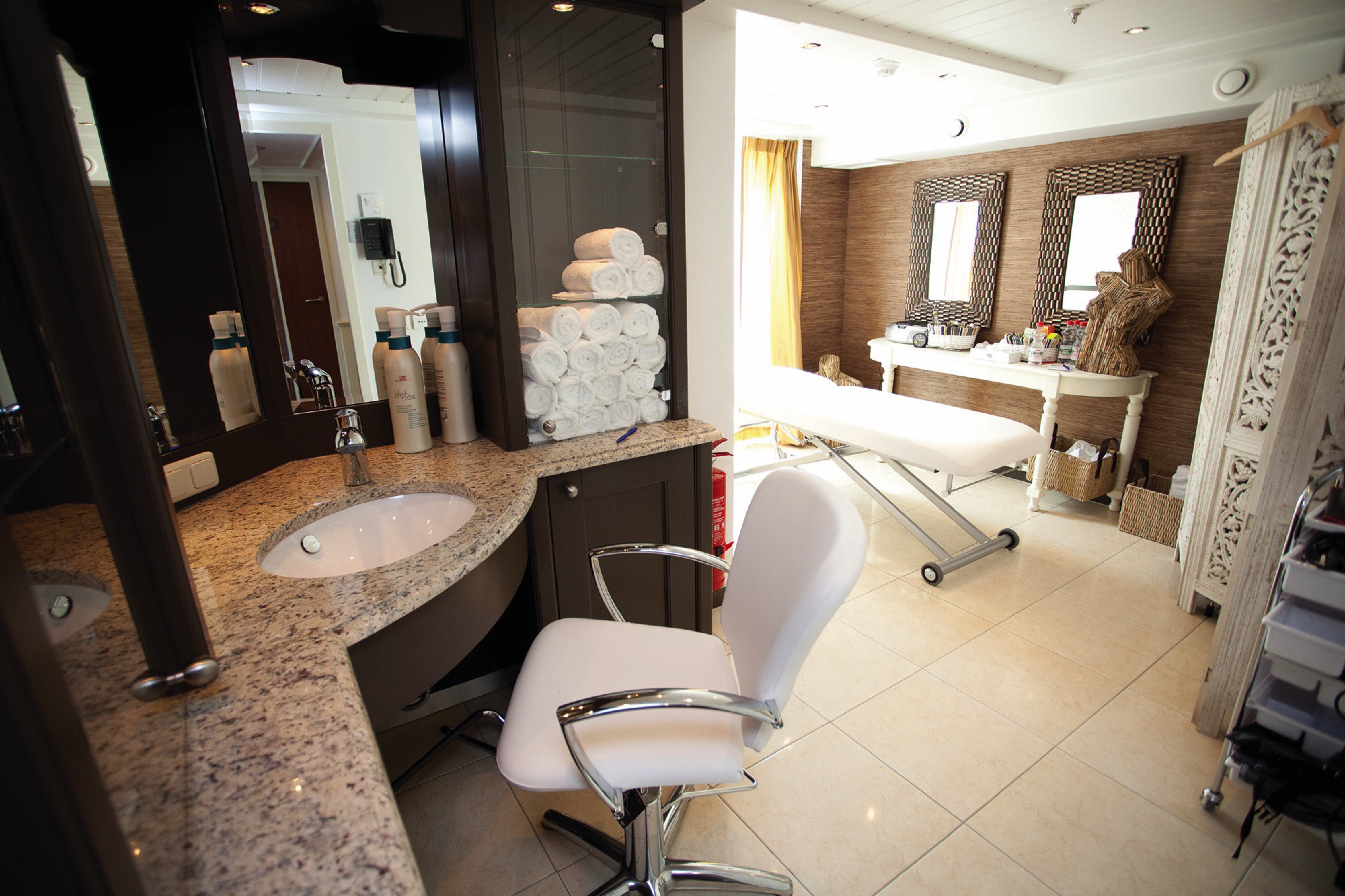
Massage Services & Hair Salon
After a marvellous day of immersive shore excursions, return to the ship and treat yourself to a bit of pampering with a soothing massage.
Age Restrictions
All guests under the age of 18 are to be in a stateroom with an adult and must remain supervised at all times; their safety is the responsibility of the accompanying adult(s). In the case where a triple or quad occupancy stateroom is not available or not selected, children under the age of 10 at the time of embarkation may share a stateroom with two adults only in circumstances where the child is able to share the bed with the adults – no additional bed will be provided. Please be aware that balcony staterooms of any kind may be unsafe for minors if left unsupervised. There is a minimum age limit of 4 years old, unless otherwise agreed upon by AmaWaterways.
On our Africa Safaris & Wildlife Cruise program, due to safety precautions, there is a minimum age limit of 12 years old, unless otherwise agreed upon by AmaWaterways.
AmaWaterways does not provide child-specific programs or child-minding facilities. Please reach out to us if you have any further questions regarding our child policy.
Disabled Facilities
Reasonable efforts are made to accommodate the special needs of disabled cruise participants, but no responsibility will be undertaken for any denial of services by carriers, hotels, restaurants, or other independent suppliers. Tour buses are not equipped with wheelchair ramps and cabin doors are not wide enough to allow access by standard wheelchairs.
Wheelchairs and walkers cannot be carried on tour buses, due to space limitations. Wheelchair passengers should be aware of these limitations. For safety reasons, passengers in wheelchairs cannot be carried on ramps in ports where the ship is at anchor. We regret that we cannot provide individual assistance to a tour member for walking, getting on/off tour busses and other transportation vehicles, or other personal needs. A qualified travel companion must accompany travellers who need assistance.
Smoking Policy
Smoking is not permitted anywhere inside any of the ships. Smoking is only permitted on the Sun Deck. For the safety and comfort of all passengers on board, your cooperation in observing the no-smoking policy is greatly appreciated.
Dietary Requirements
Please advise your Travel Agent or call us directly to advise if you have any dietary restrictions or allergies prior to embarkation. In most cases, we will do our best to accommodate special dietary requests and food allergies, but with one exception: Kosher. This diet has specific rules regarding food and its preparation and the shipboard environment does have limitations that prevent us from being able to adequately cater to this dietary need. Please note, though we can provide options to accommodate food allergies and sensitivities, we cannot guarantee there will not be any cross-contamination.
Dress Code
Comfortable, layered clothing adaptable to changing weather conditions is always advisable for daytime excursions. For the evening, “Casually elegant” attire is recommend and you may want to pack something a little dressier for the Captain’s night/Farewell Dinner – similar to how one would dress to dine at a 5-star restaurant. Comfortable shoes are recommended for excursions and workout clothing if you plan to take part in any wellness activities, active tours or use the onboard gym. Depending on the time of year, clothing that can be layered is highly recommended.
Medical Facilities
Europe: There are no medical facilities on board. However medical services can easily be called from shore if required.
Vietnam & Cambodia: We do not employ doctors or nurses on board the ships. In the event medical assistance is needed, appropriate medical facilities will be contacted. Note that response time can vary.
Africa: We do not employ doctors or nurses on board the Zambezi Queen. In the event medical assistance is needed, appropriate medical facilities will be contacted. Note that response time can vary.
Internet and Wifi Access
Europe: High-speed Internet service is available free of charge as part of the in-stateroom “Entertainment-On-Demand.” Additionally, AmaWaterways offers complimentary Wi-Fi throughout the ship.
Vietnam and Cambodia: Free Internet and Wi-Fi in the lounge with computer stations.
Africa: Free Wi Fi is available but may be limited and sporadic during certain times of the day due to the ships isolated location.
Laundry
Laundry services are available on board for a fee. Price lists are available in your stateroom. Please note that clothes cannot be dry cleaned on board.
Excursions
Europe:
Every excursion is included with your choice from up to six guided tours each day, all operated in small groups. In every city or town you visit, there is typically a sightseeing tour offered at three unique activity levels for gentle walkers, regular walkers and active walkers, along with free time to explore the city according to your own interests. The sightseeing tours can take place on foot, via motor coach, or a combination of the two. Each tour is led by a qualified, licensed English-speaking local guide or your Cruise Manager. On select excursions, we also have a “Late Starter” option for guests who wish to sleep in but do not want to miss key tour highlights. For those guests interested in exploring Europe from an exciting new perspective, we offer guided bicycle and hiking tours in select cities. In addition to our many choices of excursions we also offer our special interest tours such as wine tastings and culinary demonstrations, offering small groups the chance to be even more immersed into the local life. In the event of water level problems on certain stretches of the river, it may be necessary to operate part of the itinerary by motor coach or to alter the daily program as determined by the ship’s Captain.

Sun Deck
- Observation deck
- Navigation Bridge
- Bicycles
- Whirlpool
- Sun Deck
- Walking Track

Violin Deck
- Bow Seating Area
- Main Lounge & Bar
- Gift Shop
- Reception
- Massage & Hair Salon
- The Chefs Table Restaurant
- Fitness Suite
- Elevator
- Suites
- Cat A Stateroom
- Cat B Stateroom
- Cat C Stateroom

Cello Deck
- Main Restaurant
- Elevator
- Cat B Stateroom
- Single Stateroom
- Cat C Stateroom

Piano Deck
- Cat D Stateroom
- Cat E Stateroom
- Crew Cabins
